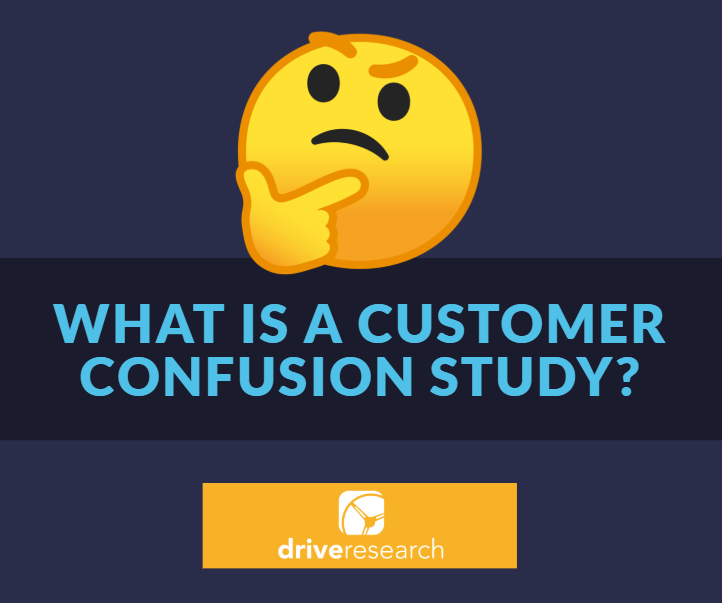Wondering what a customer confusion study is? Drive Research, market research company in New York, can help! The name customer confusion study sounds a little confusing, right?
In the following post, we will answer (1) what a customer confusion study is, (2) what the benefits of a customer confusion study are, (3) how a customer confusion study is used, and (4) an example of a customer confusion study.
Ready to learn about customer confusion studies?
On your mark. Get set. Go!

Due to increasing product lines in similar markets, customer confusion has become a serious problem for new or existing brands. Learn how a customer confusion study can measure how your brand is recognized by your target audience.
What is a Customer Confusion Study?
A customer confusion study measures one of two things. A customer confusion study can measure:
(1) The presence and how often customers tend to confuse one organization for another organization.
(2) The presence and how often customers confuse the product and/or service offered by one organization for another.
To put it simply, a customer confusion study measures the accuracy of brand recall as it pertains to product/service offering, advertisements, etc.
What are the Benefits of a Customer Confusion Study?
The benefits of a customer confusion study include measuring brand equity, product and/or service equity, advertising effectiveness, brand attributes, and more.
The results of customer confusion studies can be used to better understand how a brand, or product and/or service is viewed from the minds of customers.
It is beneficial for any brand to take an objective view of how there products and services are perceived by the masses, and more specifically their target customers. A customer confusion study assists with this challenge by providing this exact object perspective through collecting direct customer feedback.
How is a Customer Confusion Study Used?
A customer confusion study can be used for new and well-known brands as well as new and well-know products or services.
Before introducing a new product to the market, a brand would benefit from conducting customer confusion research to test the level of confusion customers have associated their product with the organization that produced it.
Alternatively, a brand may test a customer's ability to correctly identify or recall the sponsoring company in news/articles, advertisements, and more.
Each of these methods for utilizing customer confusion studies allows a brand to gain a better understanding of their target customer's mindset.
With customer confusion studies, brands can ask their target market questions such as:
- Do customers know our product/service line?
- Do customers confuse the brand with our competition?
- What competitors is the brand getting confused with?
- What are the sources of confusion?
- How can confusion be eliminated?
What is an Example of a Customer Confusion Study?
An example of a customer confusion study could be to test customers ability to accurately recall the sponsors of specific advertisement campaigns. The objective of the study is to better understand advertising effectiveness. This is particularly helpful for brands that are attempting to increase brand awareness.
The study could use several different methodologies depending on the research objectives. Our customer confusion research company has conducted this type of study through online surveys, phone interviews, or in-person/webcam interview.
For this example, the methodology of the study is to conduct 16 in-person interviews. The in-person interviews take 25 to 30 minutes to complete and are held at a market research facility. During the interview, the researcher asks participants if they recognize an advertisement of the sponsoring company or if they remember seeing it before.
It is important for a third-party market research company to conduct the research for this type of study to be effective. This eliminates bias. If research participants know the brand sponsoring the research it will affect the results. Learn more about the importance of using a third-party market research company.
A customer confusion study includes 7 steps:
- Define objectives
- Request a proposal
- Hold a kickoff meeting
- Create a project workplan
- Design the research
- Field the research
- Analyze and report on the research findings
- Debrief and discuss the research findings
Learn more about the market research process.
Drive Research is a market research company located in New York. We offer a wide range of custom market research services like online surveys, focus groups, feasibility studies, customer experience (CX) studies, and more!
Here are four ways to reach our market research company!
Message us on our website
Email us at [email protected]
Call us at 888-725-DATA
Text us at 315-303-2040
